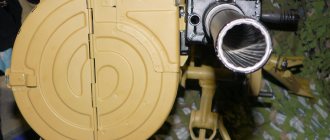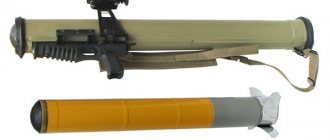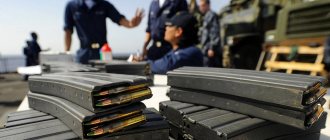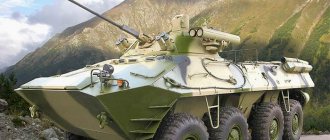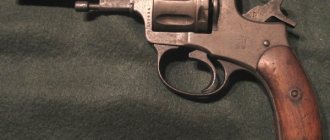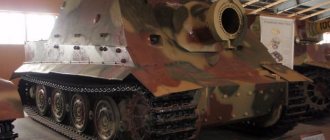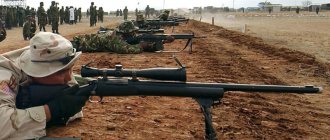In 1994, production of the RG-6 hand-held grenade launcher was launched for the needs of the Russian army. In the technical documentation it is listed under the index GRAU 6G30. Among fans of computer games, namely the STALKER series, it is known as the “Bulldog” grenade launcher. Weapons began to be created in 1993. Initially, it was planned that Russian soldiers would use the RG-6 against the intensified Chechen militants. However, thanks to its high technical characteristics, the Bulldog grenade launcher was in demand in 2008. Then the RG-6 was used in the South Ossetian armed conflict. Information about the history of creation, design, purpose and technical characteristics of the Bulldog grenade launcher is contained in this article.
A little about history
The first sample of the Bulldog grenade launcher was ready in 1994. After testing, the expert commission approved the start of small-scale production. Soon, 6 RG-6 units were produced, which were immediately handed over to Russian soldiers in Chechnya. In addition to the troops, several units of the Ministry of Internal Affairs were armed with these grenade launchers.
Due to the fact that work on the creation of the Bulldog grenade launcher was carried out at an accelerated pace, the first batches of RG-6 were produced with unreliable trigger mechanisms. The grenade launcher is available in two versions. Initially, "Bulldog" weighed 5.6 kg. This model is equipped with 103 mm chambers for VOG-25 ammunition, which is considered standard. Soon they started producing grenade launchers with 125-mm chambers. This RG-6 can fire the VOG-25P, which the military also calls a “jumper.” The weight of the grenade launcher has been increased to 6.2 kg. There are no letter or index differences in the two versions of RG-6.
We have the RG-6 grenade launcher, what about them?
Revolver-type hand grenade launchers have long established themselves as effective and relatively compact weapons. Of course, such a device cannot be hidden in your pocket, and with ammunition it weighs nothing like a feather. But everything is learned by comparison, and the ability to bombard an enemy position with grenade launcher shots at a sufficiently long distance with a relatively high rate of fire negates all far-fetched disadvantages in the form of discomfort during transportation.
Revolver-type grenade launchers have gained considerable popularity in cinema and computer games, so we can talk about that rare exception when the effectiveness on the screen is comparable to the effectiveness in reality.
If we talk about efficiency, then, as elsewhere, the main characteristics are determined by the ammunition used, while the weapon itself is only a means of delivery to the target. In this article, we will approach the issue somewhat “from behind” and try to consider hand grenade launchers in the context of their design, namely revolver-type hand grenade launchers. Well, in order to at least slightly equalize their characteristics, we will consider designs powered by shots of 40 mm caliber.
There will be no comparison and a conclusion in the form of choosing the best revolver-type hand grenade launcher, since for such conclusions you need to at least have access to all the samples under consideration with the possibility of testing them at the test site. But you can point out the obvious disadvantages and advantages of the design.
Milkor MGL, or M32 MGL
After the purchase and quite successful use of American M79 hand grenade launchers in South Africa, the country's military puzzled the designers: the main drawback of such weapons, namely single-shot capability, had to be eliminated. The solution to the problem did not take long to arrive, especially since the solution itself was on the surface and has been known for decades. Taking the revolver weapon power system as a basis, the designers produced a prototype of a hand-held grenade launcher in just one year. And two years later, in 1983, mass production of a revolver-type hand grenade launcher, known to us as MGL, began.
The design of the weapon was modified several times: in 1998, in 2004 and in 2008. However, nothing fundamentally new was done, except for the fact that in 2004 two versions of the weapon appeared with the designations L and S, differing from the first models in shape drum, and from each other the length of the chambers. It is these grenade launchers that are currently being mass-produced, and are used in the US Army under the designation M32. It turns out that the United States once gave South Africa its M79, and a few years later South Africa gave the United States the M32 MGL. This is the cycle of hand grenade launchers in nature.
Since at the moment only the 1998 and 2004 versions of grenade launchers are common, we will give figures for them.
All three variants of grenade launchers are fed from a drum with six chambers, 40x46 grenade launcher rounds. The 1998 version of the grenade launcher is designated MGL Mk.I. Its weight without ammunition is 5.3 kilograms. The length of the weapon varies from 630 to 730 millimeters, depending on how extended the butt is, which ensures that the weapon fits the shooter’s build. The first versions had a fixed-length folding stock.
The two 2004 grenade launcher variants have the following characteristics. The MGL Mk.IS model boasts a weight of 5.6 kilograms. The weapon has become thicker due to the fact that the drum has been changed, the outer surface of which is now wavy and does not collect dirt. The length with the butt moved/extended is 674/775 millimeters. Variant of weapons with the letter L in the name. The main difference between this weapon and the two previous models is the elongated drum chambers, which grew from 105 millimeters to 140. Accordingly, the weight of the weapon also increased, which became equal to 6 kilograms, but the hand grenade launcher was able to use a wider range of ammunition. The length of the weapon with the butt moved/extended is 674/775 millimeters.
It would be useful to clarify that there is another modification of this revolver-type hand grenade launcher, dating back to 2008, namely the MRGL. As far as I understand, this development is no longer limited to Milkor only. This weapon is designed to use both standard ammunition, its extended variants, and 40x51 rounds with a higher flight speed. That is, the weapons, roughly speaking, are the same, but the shots are different. If we look at the grenade launcher externally, the main thing that differs from its predecessors is the barrel length, which decreased from 300 millimeters to 260. The drum chamber became slightly shorter (by 4 millimeters), which led to the fact that the weapon can be fed with all ammunition based on a 40x46 grenade launcher round and their extended variants, plus new, “faster” ammunition. With all this, the dimensions of the hand grenade launcher remained within the limits of its “short” versions: 676 and 756 millimeters for the moved and extended butt.
Numbers are good, but the design of this grenade launcher is much more interesting. While working on a new weapon, Milkor designers encountered the problem of turning the drum. Such a massive part did not want to turn as in a revolver, under the action of the shooter’s muscular force, when pressing the trigger or cocking the hammer, and putting a high-quality expander in each set of weapons was prohibitively expensive. The solution to this problem also turned out to be known: the weapon’s drum is driven by a spring, which is compressed when the grenade launcher is reloaded.
Despite the simplicity of this solution, the designers of the Milkor company decided to slightly complicate the operation scheme, and at the same time the life of subsequent weapon users. The ratchet mechanism of the drum is released at the moment of the shot, and the piston, driven by the powder gases of the expelling charge, is responsible for this moment. For the consumer, this meant more difficult cleaning of the weapon, which is not such a big problem. A much bigger problem is that turning the very heavy drum when firing affects the accuracy of the fire, and although the grenade launcher is not a sniper rifle at all, this drawback still has to be taken into account.
At the moment, a huge amount of ammunition has been developed based on the 40x46 shot, from high-explosive fragmentation to ammunition filled with rubber shot or mucous irritants. Among the latest developments, we can note a shot in which a camera and a small parachute are placed. In theory, such a device should help navigate the battlefield, giving an idea of the location and movements of the enemy. In practice, the camera lens cannot show a large area of the combat area, since the camera itself is located relatively low. In other words, while you are looking at the cloudy picture on the small screen, trying to understand where is up and where is down, the enemy can slowly step closer to arm’s length.
Much more interesting is the grenade launcher shot, which fires a flare, only it shines in the infrared range of night vision devices, which gives excellent visibility at night. True, if the enemy also has NVGs, then he will see no worse.
At the moment, MGL hand grenade launchers are widespread in NATO countries and are actively used outside this bloc. Production is established both in Europe and Africa, and, of course, in China. This grenade launcher is considered the direct and only competitor of the domestic RG-6, often making comparisons, although in this case it is not so much weapons that need to be compared as ammunition. In addition, the MGL is not the only revolver-type hand grenade launcher, although it is quite common.
MM-1 hand grenade launcher
Of course, looking at the success of designers from South Africa, American gunsmiths could not stand aside. In 1985, Hawk Engineering proposed its own version of a revolver-type grenade launcher. Doing the same thing as in South Africa would have been strange, and there weren’t many options for improving the design. In this case, we can safely say that the best is the enemy of the good and here’s why.
In order to surpass the product of their African colleagues, it was decided to make a weapon with a more capacious drum, and half-measures in the form of increasing to 7-8 chambers in the drum were considered insufficient and, having decided that it was a walk in the park, they made a grenade launcher with a drum in which 12 shots were placed. This did not affect the mass of the weapon itself. Thanks to plastic and light alloys, the grenade launcher weighs 5.7 kilograms without firing. But if we take 220 grams as the mass of the shot, we get some interesting math: 5.7+(0.22*12)=8.34 kilograms.
But the weight of the weapon is far from the main drawback; the weight of the drum with shots is much more important. The basis for this hand grenade launcher was exactly the same system that was used in similar weapons from South Africa. That is, in order for the drum to move during firing, during reloading the drum spring must be compressed, and the spring is released under the action of the powder gases of the expelling charge. As you might guess, in the design of the grenade launcher itself, the heaviest part is the drum, to which is added the weight of 12 shots. During the shooting process, this entire mass will try to move the weapon to the side, which will negatively affect the accuracy of the fire.
It is quite logical to note that a hand grenade launcher is not only not a sniper rifle, but also not a machine gun, and with the introduction of corrections for the weapon’s deflection, as well as with normal aiming before each shot, all these negative aspects can be ignored from a high bell tower. But there is one detail in this weapon that distinguishes it from both the South African design and all revolver-type hand grenade launchers. The MM-1 grenade launcher can fire in bursts.
As is already clear from the number of chambers in the weapon’s drum, American designers do not accept half measures, and if they are going to improve, then improve in full. The rate of fire is low - 150 rounds per minute, however, the rotation of the drum, even at this rate of fire, will already have a significant effect. In addition, do not forget about recoil during shooting.
The ability to fire automatically from this weapon would be more than justified when installing such grenade launchers on vehicles, machine tools, and so on, in “manual mode”, as it seems to me, this is rather an irrational waste of ammunition.
It would be unfair to talk about the shortcomings of the design, but remain silent about its advantages. As mentioned above, it is possible to overcome the design flaw, when the drum rotates immediately after the shot, which has been proven by the quite successful and accurate use of this weapon, so if you don’t find fault, you can turn a blind eye to this. This same design has one notable feature that can be very useful in case of an emergency. So, if after pressing the trigger the weapon does not react in any way, then you can try to shoot again or wait until the weapon fires, in case of a prolonged shot. The situation is rare, but possible, that is, until the shot occurs, the drum remains motionless. If we draw a parallel with the operating mechanism of RG-6, then there may be options, but more on that below.
As mentioned above, the mass of an unloaded MM-1 hand grenade launcher is 5.7 kilograms. Feeding is carried out from a 12-chamber drum with 40x46 rounds, while the use of longer ammunition is impossible. The length of the weapon is 635 millimeters without the stock. Stocks can be mounted on AR-15 rifles and the like. Reloading is carried out by tilting the rear part of the grenade launcher to the side along with the pistol grip for holding. Just like other six-shot grenade launcher models, the drum is loaded one shot at a time, while the drum spring can be charged separately.
The weapon turned out to be oversized and completely inconvenient for transportation due to the drum. Despite this, the MM-1 grenade launcher was put into service with the US Army, but it did not become widespread or widely known outside the homeland, but it is a fairly frequent guest in games and films, which creates an incorrect feeling of its ubiquity.
Bulgarian hand grenade launcher "Avalanche", aka Avalanche MSGL
In 1993, the Arsenal arms company completed work on its version of a revolver-type hand grenade launcher. Obviously, the development was started by the success of a foreign model from Africa and the start of work on similar weapons in Russia. But in the arms market, the principle “who stood first gets the boot” does not always apply. Despite the fact that the production of this grenade launcher began earlier than the RG-6, it did not become widespread, although it is a very interesting weapon due to the totality of its characteristics.
First of all, it is necessary to note the very small dimensions of the Avalanche hand grenade launcher (not to be confused with the Soviet TKB-0218). This is, without exaggeration, the most compact example of such a weapon. Its length with the butt folded is only 388 millimeters, and with the butt unfolded it is 525 millimeters. Such compact dimensions can be explained very simply - the weapon is not a revolver type, but a pepperbox, that is, it does not have a barrel as a separate part. Having estimated that the length of the drum chamber and the presence of rifling in it was quite enough for the weapon to have at least some accuracy for its niche of use, they decided to remove the barrel from the design. The result of the “circumcision” did not significantly affect the combat characteristics of the weapon, in short, everything was the same as with people.
The mass of the grenade launcher did not decrease after removing the barrel, since in order to conveniently hold the weapon during shooting it was necessary to make a fore-end under the drum. The weight of the Avalanche hand grenade launcher in the unloaded position is 6.3 kilograms, with a full drum the weight of the weapon is about 7.8 kilograms. The drum has 6 chambers into which VOG-25 rounds and the like are placed.
In front of the drum there is a plate with a hole in front of the upper chamber; through this hole both the weapon and its equipment are discharged alternately into each chamber of the drum. The drum rotates during loading, which compresses the spring, which is the main element that drives the drum during the firing process. The weapon is again discharged one shot at a time, for which there is a pusher at the bottom of each chamber, when pressed, the shot is removed from the weapon. Pressing is done using a button on the left side of the weapon, located above the safety switch.
The trigger mechanism of the grenade launcher is self-cocking, double-action; unfortunately, it was not possible to determine whether it is hammer- or striker-operated. The principle of operation of the grenade launcher is similar to that of the RG-6. When the trigger is pressed, the firing mechanism is cocked and disrupted, which leads to a shot; after the trigger is released by the shooter, the drum spring rotates the drum 60 degrees, exposing a new shot to the striker. Since the design of grenade launcher rounds is “caseless,” after using up the ammunition, you can immediately begin loading the weapon without wasting time removing spent cartridges. However, as the practice of using other grenade launchers shows, such a procedure does not take much time, or rather, it does not take any time at all, since after opening the drum, the cartridges themselves fall under their own weight. The only inconvenience associated with this is that you can trip over them.
To ensure a more comfortable perception of recoil by the shooter, the butt of the grenade launcher is equipped with a damper that stretches the recoil moment; in addition, a rubber pad is installed on the butt of the weapon, which also plays the role of a shock absorber.
Separately, it should be noted that this design of the grenade launcher does not allow for an easy transition of weapons to NATO standard ammunition, where the shots have a cartridge case; as a result, it is easier to make a new weapon than to try to modernize an old one.
This grenade launcher is used by both the Bulgarian armed forces and law enforcement agencies in combination with non-lethal grenade launcher rounds; this grenade launcher is also offered for export, but is not in great demand.
To be objective, the Bulgarian designers turned out a good weapon, albeit with an unusual appearance. On the other hand, you can’t marry a grenade launcher, and if it fully satisfies all the requirements that the military places on it and is sufficiently effective, that is, it has a barrel, or if it doesn’t have a barrel, that’s a big deal. The only drawback, or rather a feature of the weapon, is that the weapon is loaded through a hole in the front shield in front of the drum. In other models of grenade launchers, where the drum tilts to the side, you can pre-compress the drum spring, and then insert shots into the chambers one by one. In the Avalanche hand grenade launcher, the rotation and loading procedure alternates, which increases the weapon reload time compared to other models.
RG-6 hand grenade launcher
Well, we finally got to the domestic product. We owe the appearance of the RG-6 hand-held grenade launcher in service to the designers V. N. Telesh and B. A. Borzov. It should be noted that the work of the designers was quite hasty. In November 1993, an order was issued for a new weapon, and already in March 1994 a test batch of weapons was released, which was immediately sent for testing, and the tests were not limited to just the training ground, they tested the new grenade launcher in combat operations in Chechnya. There, the grenade launcher received only positive reviews and, taking into account the wishes of not the command, but the end user of the weapon, the RG-6 began to be mass-produced. Unfortunately, it was not possible to find reliable information about the use by the opposing side of grenade launchers of a similar design, but with all that motley zoo of weapons, there is no doubt that it was there, because the RG-6 was clearly not out of place on the battlefield.
If we talk about any specific features or innovations in the design of weapons, then it is impossible to single out anything. Everything was implemented earlier in other samples, of a different class, but if you take into account the time that was spent on developing weapons, it becomes clear that the designers were not required to invent, they were required to do.
You need to start with the grenade launcher drum. The drum consists of 6 chambers, each of which has 12 grooves. The bottom of the chambers is blank, there are only holes for the firing pin to enter and for the ejector rod to discharge the weapon. The grenade launcher drum is driven by a torsional coil spring. The spring is twisted manually when the drum is loaded with shots. To reload, the drum, together with the butt and the holding handle, is turned upward.
The barrel of the weapon has no rifling, a simple sighting device is installed on it, and an additional handle at the bottom for holding.
The trigger mechanism of the RG-6 grenade launcher is self-cocking and has its own interesting features. The firing pin itself is in direct contact with the grenade launcher capsule and is held in its rear position. Given the very small mass of the striker, this solution turned out to be quite safe; neither falls nor impacts lead to an unexpected discharge of the weapon, but at least one spring was eliminated from the design. The second feature is that after the shot, the drum remains in place, just like the Bulgarian Avalanche grenade launcher; the drum rotates when the trigger is released.
Protection against an accidental shot is organized using a safety switch, plus a kind of protection is the force when pressing the “trigger”. Additionally, the safety of handling the weapon is ensured by an automatic safety lock, which blocks the trigger when the barrel block is not completely closed.
On the Internet you can often find stories about how, with a prolonged shot, in different variations: a) everyone was killed; b) they managed to throw away the weapon and no one was hurt; c) any other option, up to “a bear ran out of the forest, lay down on a grenade launcher and saved everyone.” The stories are interesting, colorful, and each time they are filled with new details. Indeed, the solution of turning the drum when the trigger moves back is not the most successful in such a non-standard situation. However, it remains not entirely clear why, knowing this feature of your weapon, if you press the trigger and do not feel or see the expected result, release this same trigger. If you already release the trigger, you can look into the barrel to see what’s there, you never know what’s stuck.
To reduce the length of the RG-6 hand grenade launcher, the butt is made removable; in the stowed position, the length of the weapon is 520 millimeters, and in the firing position, 680 millimeters. The weight of the grenade launcher without shots is 5.6 kilograms. The sights are designed for firing up to 400 meters, although at maximum distances, the butt has to be held under the armpit to aim. The weapon's lifespan is from 2500 to 3000 shots, which is a very good result for a hand-held grenade launcher.
To be objective, the RG-6 weapon is quite crude. A pair of tubes, a barrel-drum block and a trigger from the GP-25, despite this, the grenade launcher is at least not inferior to foreign competitors in any way. The advantage of this weapon is its price, which is significantly lower than its South African counterpart. During its short existence, the RG-6 hand grenade launcher has proven itself to be a fairly reliable and effective weapon, easy to learn and maintain, although not without drawbacks in the form of small parts that can be lost when servicing the grenade launcher in the field.
Conclusion
I foresee criticism in the designation of individual elements of the weapon indicated in the article. In particular, the designation by a trunk of something that is not inherently a trunk, but only looks like it. So, for example, in the same RG-6, the sighting devices and the handle for holding are located on the false barrel, while the chambers of the drum are precisely the barrels of the weapon with the rifled part. There is nothing to counter this, except perhaps by the location of these elements in the structure. Therefore, it would probably be more correct to designate such grenade launchers not as revolver-type weapons, but as pepperbox grenade launchers, but it seems to me that this is not such an important nuance that is worth focusing on.
As is clear from the article, revolver-type grenade launchers for forty-millimeter shots are a weapon in demand, but their designs are not as diverse as in other classes. The designs themselves are characterized by maximum simplicity and low cost, which can be explained by the cost of the shots. With expensive shots, the weapon is also expensive - an unaffordable luxury. Despite this, gunsmith designers still have room to move both in improving existing models and in developing new designs. The main disadvantage of revolver-type grenade launchers is their slow reloading of one shot at a time, which still needs to be individually removed. That is, even in the direction of developing additional devices, there is room for improvement.
Separately, it is worth mentioning the range of ammunition. Despite the fact that most of the shots developed on the 40x46 base are not all successful, one option in a dozen “fires” and is adopted for service. It would seem that with the current abundance of options for domestic grenade launcher rounds, all niches of use have been covered, but no one forbade striving for more. Lowering cameras on parachutes is, of course, overkill, but there is still room for improvement, since at the moment we are already lagging behind in this regard.
Sources of photos and information: weaponland.ru modernweapon.ru forum.guns.ru
Description
The basis for the RG-6 was the South African MGL Milkor grenade launcher. Due to the fact that it was planned to fire fundamentally different ammunition from the Russian RG-6, the designs of these grenade launchers are somewhat different. The Milkor was equipped with cased ammunition, and the Russian one with caseless ammunition.
According to military experts, the advantage of the RG-6 lies in its combat rate of fire. The fact is that after shooting, the fighter does not waste time extracting the cartridge case. The design of the grenade launcher is represented by the following elements:
- False barrel equipped with a handle.
- Six-shot drum.
- Folding telescopic buttstock.
- Folding sight. Step length 50 m.
- Trigger mechanism.
- Central frame of skeletal type.
The barrel in the RG-6 is not used as a casing; it is primarily intended for convenient use of the weapon. If necessary, a fighter can rest him at the edge of one or another cover. In order to ensure comfortable holding during shooting, the designers attached a handle to the barrel. The grenade launcher fires VOG-25 ammunition. A six-shot drum was equipped with rifling for them. Thanks to the rifling, when flying out of the RG-6, the grenade rotates along its axis, which has a positive effect on the accuracy of the battle.
The drum is rotated by means of a special spring. Before firing a shot, in order for the spring to cock, you need to turn the drum. On the side there is a place for a shot counter. To make the Bulldog smaller in size, it was decided to equip it with a folding telescopic butt. Judging by the reviews, there is almost no recoil felt during shooting. It is extinguished by a damper butt, which is placed inside the telescopic one.
TTX
The Russian RG-6 grenade launcher has the following tactical and technical characteristics:
- Refers to a type of hand-held revolver grenade launchers.
- The total length in combat position is 68 cm, in stowed position – 52 cm.
- The grenade launcher weighs 5.6 kg.
- Barrel with a diameter of 40 mm.
- Designed for 6 rounds of ammunition.
- Within a minute, up to 14 shots can be fired from the RG-6.
- The maximum combat range is 400 m, the sighting range is 150 m.
- In one second, the projectile covers a distance of up to 76 m.
Grenade launcher 6G30
The 6G30 hand-held anti-personnel grenade launcher is designed to destroy enemy personnel located openly, as well as those located in trenches and on reverse slopes of terrain.
Basic technical data: Caliber – 40 mm Number of barrels in the block – 6 Shot weight – 255-278 g Grenade launcher weight – 6.2 kg Length with the butt folded down – 690 mm Length with the butt folded – 520 mm Width – 145 mm Height with the butt folded down – 280 mm Height with the stock folded – 200 mm Sighting range – 100-380 m Practical rate of fire – 12 rounds per minute Resource – 2400 rounds
In what games does it appear?
You don’t have to be a military man to experience all the advantages of the Russian grenade launcher. Fans of computer games have this opportunity, namely “Marauder”, 7.62, Alien Shooter 2, “Alpha. Anti-terror", Operation Flashpoint: Cold War Crisis and "Stalker".
The Bulldog grenade launcher, judging by numerous reviews from gamers, is very effective in cases where it is necessary to destroy armored vehicles and large enemy concentrations of mutants. In Stalker, it is more advisable to use these grenade launchers if the enemy is outnumbered, or if mutants are too tenacious.
Interesting Facts
- NPCs with a grenade launcher will most likely die in the first battle, since they can shoot themselves at their feet without thinking.
- Using a grenade launcher, you can “jump” higher by shooting underneath yourself. This way you can even jump over the map.
- NPCs using a grenade launcher cannot be encountered, since the NPC logic is adjusted only for rifles. Although you can give it yourself. Moreover, NPCs can even be forced to use a grenade launcher. Only Voronin can “honestly” use the grenade launcher if he completes the quest to steal the Bulldog for Duty.
- The creators wanted to make a smoke version of the ammunition, but they discarded this version as well as the smoke grenade. This was due to the inability to create consequences for NPCs after being shot. However, the smoke grenade is used in online mode.
- In the book “Monochrome”, the bartender Chizhik fired once within the walls of the bar at the attacking military, which turned the military into “mincemeat”, and he himself received a concussion from this. However, in reality, under-barrel grenades have a cocking time, i.e. it needs to travel a distance of about 20 meters before it can explode, so firing a grenade launcher/grenade launcher indoors will do nothing - the grenade simply won't work.
- You can shoot without wasting ammunition. To do this, you need to unload the grenade launcher through your inventory. Shoot unloaded; such a shot does not waste charges and is silent (near the site of the FOG explosion it is noisy as before). Next, you need to hide the grenade launcher so that it does not charge. Reach-shoot-hide and so on 6 times, counting with the first. The second method is almost the same as the first. You need to unload the Bulldog-6 and throw the cartridge out of the inventory, then you need to pick up the cartridge (the GG will not reload the grenade launcher until you enter the inventory), quickly go into the inventory and quickly throw the cartridge out of the inventory again. We do this six times (since the Bulldog has only six cartridges). After these steps you will shoot without ammo and kill. In this case, it is not necessary to have all six grenades with you; one grenade is enough.
